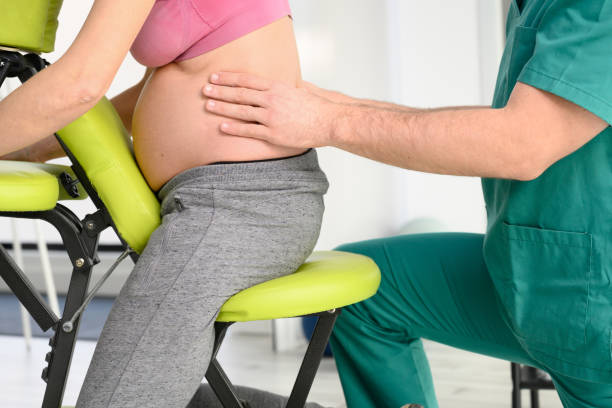
Sports physiotherapists promote safe physical activity participation. They also provide professional services to players requiring treatment for acute injuries.
Although the physical changes of OA identified by x-ray cannot be reversed, physiotherapy can significantly improve pain, movement and strength in people with this condition.
1. Manual Therapy
Manual therapy is a hands-on physiotherapy technique that can decrease patients’ levels of pain and improve their functionality [8,9]. It involves the physical therapist applying passive movements to the joints and the related soft tissue structures, such as muscles, ligaments, and tendons. Its objective is to modulate pain, increase the range of motion of the joint, reduce soft tissue inflammation, instill relaxation, and improve repair or extensibility or stability of contractile and noncontractile tissue.
In a recent systematic review of 22 randomized controlled trials, a physiotherapy intervention including manual therapy was associated with a significant reduction in pain (VAS and Western Ontario and McMaster osteoarthritis index) scores. The studies included a total of 2,199 participants who had symptom duration of approximately 7.5 years and were randomly assigned to either a group receiving a physiotherapy treatment including manual therapy or a control group. Physiotherapy interventions in the trial included various techniques such as mobilization, muscle stretching, and passive physiologic movement of the knee, hip, and lumbar spine. The control groups received non-specific treatments such as sham ultrasound and non-forceful manual contact, education brochures, exercise, transcutaneous electrical nerve stimulation, electro-acupuncture, rehabilitation or oral administration of NSAIDs.
Sports physio in Canberra will not only be able to identify the injury, but also be able to assess the biomechanical factors contributing to the problem and then implement a strategy to correct the dysfunction. They may use a combination of the following physiotherapy techniques:
Abbey Physio is dedicated to helping individuals recover from injury and return them back to their pre-injury level of function at all age and abilities, from the weekend warrior to the elite athlete.
Our physiotherapists are highly trained in the assessment and treatment of injuries resulting from sporting and exercise activities at all levels and ages. They can advise you on the appropriate training, recovery, and injury prevention strategies for your injury and are happy to work with your other health professionals, including surgeons, sports doctors, and GP’s. We can also liaise with your insurance company and medicare to ensure you get the best possible care.
2. Aquatic Therapy
Aquatic therapy, also known as pool-based physical therapy and aquatic exercise, is a safe and effective treatment option for anyone who wants to lose weight, build muscle, or improve their posture. The warm water encourages deep breathing and relaxation which helps relieve stress, while the resistance of the water increases muscle strength in a way that is gentle on joints.
Unlike a gym, where the weight of barbells and other equipment puts strain on the joints, resistance from the water is uniform throughout the whole body. This means that even someone with a severe injury can safely and effectively perform resistance training in the water, preventing any joint damage or discomfort.
The buoyancy of the water reduces the force of gravity on muscles and joints, while allowing the individual to move freely in the water without fear of falling or hurting themselves. This makes it ideal for those with injuries, disabilities, or chronic conditions such as arthritis and fibromyalgia. The warmth of the water relaxes muscles and increases blood flow, which decreases swelling, eases pain, and improves movement.
During therapy sessions, an experienced physiotherapist will supervise the client, ensuring safety and proper form during each exercise. They may ask questions about the client’s medical history and their lifestyle, as well as what sports they play, in order to better assess the patient’s needs and determine whether or not aquatic therapy is an appropriate treatment technique for them.
In addition to the physical benefits of the warm water, aquatic therapy provides social interaction and can be done solo or with a group, depending on the patient’s preference and ability. This can help patients overcome any apprehension they may feel at first, which will help them stick with their sessions and progress towards their goals.
Aquatic therapy is a highly effective method for managing osteoarthritis and reducing symptoms of other chronic conditions, such as fibromyalgia and back pain. As a result, it has become increasingly popular for individuals to use water-based exercises in place of traditional land-based workouts. However, it is important to note that anyone who wishes to use water-based exercises must be trained in aquatic therapy by a qualified physiotherapist and have an up-to-date CPR certification, as well as certification in oxygen administration, automated external defibrillation, and blood-borne pathogen awareness (check your local codes for requirements). Those who are interested in learning more about this technique can contact a reputable physiotherapy company like HydroWorx, which offers a variety of high-quality water exercise equipment and accessories.
3. TENS
In the field of sports physiotherapy, TENS is a physiotherapy technique that involves the application of low-voltage electrical impulses through electrodes placed on the skin to provide pain relief. The intensity of the TENS pulses can be adjusted, depending on the patient’s tolerance. TENS can be used on the muscles, joints, ligaments and soft tissues of the body. It is a highly effective and non-invasive treatment for pain management.
TENS has been shown to reduce both evoked and spontaneous pain in individuals with OA. However, little research has been conducted on the effectiveness of TENS in reducing deep-tissue hyperalgesia induced by OA. This study was designed to compare the effects of HF-TENS, LF-TENS and placebo TENS on deep-tissue hyperalgesia in individuals with knee OA. This study also assessed the effects of these treatments on 6-MWT performance.
A key component of a physiotherapy program for people with OA is the promotion of functional exercise and maintenance of mobility. However, many individuals with OA are not able to perform normal activities without experiencing pain. This study evaluated the effect of kinesiotherapy, ultrasound and TENS treatment on improving the 6-MWT walking capacity of individuals with knee OA.
Participants were randomly assigned to one of three TENS groups: HF-TENS, LF-TENS or placebo TENS. They were then asked to perform the 6-MWT with no pauses or stops and their 6-MWT performance was recorded. The examiners who performed the testing were blinded to treatment group and did not disclose the nature of the control TENS to the participants.
The results indicated that HF-TENS and LF-TENS significantly increased 6-MWT distances, while placebo TENS did not. HF-TENS and LF-TENS reduced both evoked and spontaneous pain, and HF-TENS significantly improved deep-tissue pain sensitivity. However, HF-TENS and LF-TENS did not improve the TUG or WOMAC score.
Patients who suffer from a sport injury should seek out a specialist physiotherapist to ensure that they receive the best care possible. Those who ignore their injuries can face more serious problems down the line, including a longer recovery time. Our team of physiotherapists are trained to diagnose and treat sports injuries in Alexandria, Erskineville, Newtown and Marrickville. They can help you recover from your injury and prevent future sports injuries from occurring.
4. Steroid Injections
Steroid injections can be used to manage osteoarthritis, a condition which causes painful inflammation in the joints. These injections can reduce the swelling of the affected area, which in turn helps to relieve the pain. The physiotherapist will assess the condition of your joint to ensure that it is appropriate for an injection and will then inject the medication into the affected area. It is possible that you may experience some discomfort from the injection, but this usually settles within a few hours and can be eased with some simple painkillers like paracetamol.
Several different types of steroids are available for injection, and the choice will depend on a variety of factors, including the type of arthritis you have, the extent of your symptoms, other treatments you are receiving and your overall health. Doctors generally limit the number of injections they give in a particular joint to about three to four per year. This is because repeated injections can weaken bone, ligament and tendons in the affected area.
The injection is given into the joint using a small needle. Depending on the size of the needle, you may feel some discomfort at the injection site, but this is typically mild and short-lived. If you are taking blood thinners, steroid injections can cause bleeding at the injection site. Doctors will only carry out steroid injections in these circumstances with great caution and care.
A steroid injection can also increase your blood sugar levels and is not recommended for people with diabetes whose blood sugar is not well controlled. It is not advisable to have steroid injections in areas where you have an infection or are expecting an operation. Physiotherapists will advise you on whether you are able to have an injection in your affected area if you are pregnant or breastfeeding.
You should avoid consuming alcohol around the time of your injection. You should also be aware that steroid injections can affect your immune system and make you more susceptible to infections, particularly in the first two days after the injection. Some doctors will not allow you to have an injection close to the time of vaccination, and you will need to check with your healthcare team if this is the case.








































